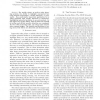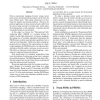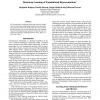1270 search results - page 43 / 254 » Dogged Learning for Robots |
ICRA
2002
IEEE
14 years 1 months ago
2002
IEEE
Abstract— For mobile robots, as well as other learning systems, the ability to highlight unexpected features of their environment – novelty detection – is very useful. One pa...
CHI
2010
ACM
13 years 5 months ago
2010
ACM
Teaching is inherently a social interaction between teacher and student. Despite this knowledge, many educational tools, such as vocabulary training programs, still model the inte...
AROBOTS
2010
13 years 5 months ago
2010
Social learning in robotics has largely focused on imitation learning. Here we take a broader view and are interested in the multifaceted ways that a social partner can influence t...
ICRA
1998
IEEE
14 years 29 days ago
1998
IEEE
: Precise sensorimotor mappings between various motor, ensor, and abstract physical spaces are the basis for many robotics tasks. Their cheap construction is a challenge for adapti...
CONNECTION
2006
13 years 8 months ago
2006
To be autonomous, intelligent robots must learn the foundations of commonsense knowledge from their own sensorimotor experience in the world. We describe four recent research resu...



